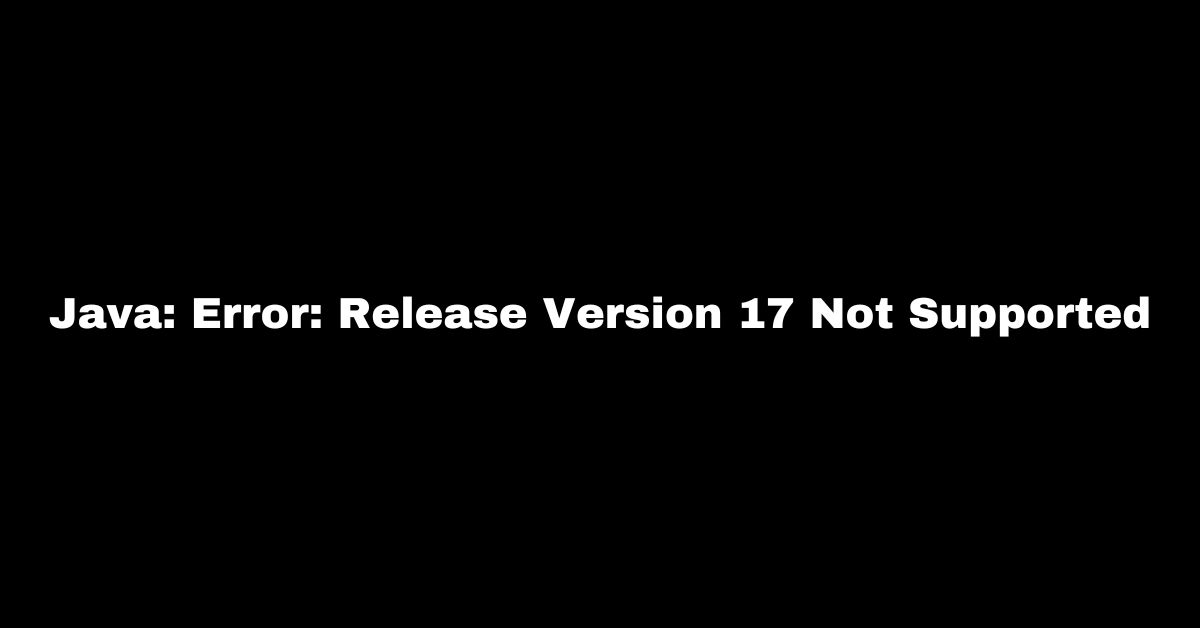|
Getting your Trinity Audio player ready... |
Introduction
Have you ever been in the middle of a Java project only to be hit with the dreaded “Release Version 17 Not Supported” error? If so, you’re not alone. This error can be frustrating, especially when you’re trying to take advantage of the latest features Java 17 has to offer. Understanding why this error occurs and how to resolve it is crucial for any Java developer working with modern versions of the language.
In this article, we’ll dive into the nitty-gritty of this error, explore why it happens, and provide you with step-by-step solutions to get your project back on track. Whether you’re a seasoned Java developer or just getting started, this guide will help you navigate the complexities of Java version management.
Understanding Java Release Versions
Java’s release cycle can be a bit tricky to navigate, especially with the introduction of a six-month release cadence by Oracle. This means that new Java versions are released more frequently, but not all of them are created equal.
Java versions can be categorized into Long-Term Support (LTS) versions and non-LTS versions. LTS versions, like Java 8 and Java 11, receive extended support and are generally preferred for enterprise applications. Non-LTS versions, on the other hand, have a shorter support window and are mainly for those who want to stay on the cutting edge.
Understanding these differences is key to managing your Java projects effectively. If you’re running into version-specific errors, it often means there’s a mismatch between the version of Java you’re using and what your tools or IDEs expect.
The Specifics of the Error
So, what does “Release Version 17 Not Supported” actually mean? In simple terms, it indicates that your current development environment doesn’t recognize Java 17 as a valid release version. This error typically pops up when your project or tools are set to a version that doesn’t support Java 17, causing the build process to fail.
Common scenarios where this error occurs include:
- Using an older JDK or JRE: If your system is still running an older version of Java, it might not recognize the new features and syntax introduced in Java 17.
- Outdated build tools: Tools like Maven, Gradle, or Ant may not be configured to work with Java 17, leading to compatibility issues.
- IDE misconfigurations: Your Integrated Development Environment (IDE) might not be set up to use Java 17, causing errors during compilation or runtime.
Why You Might Encounter This Error
Encountering this error usually boils down to a few common issues:
- Incompatibility with older Java versions: If your system’s JDK is outdated, it won’t support the syntax and features of newer versions like Java 17.
- Build tool configuration issues: Maven, Gradle, and Ant need to be explicitly configured to use the correct Java version, and if they aren’t, you’re likely to run into problems.
- IDE settings problems: If your IDE is still configured to use an older JDK, it won’t recognize Java 17, even if it’s installed on your system.
How to Diagnose the Issue
Before jumping into solutions, it’s important to diagnose the root cause of the problem. Here’s how you can do it:
- Check Your Current Java Version: Open your terminal or command prompt and type
java -version. This command will display the current Java version installed on your system. If it’s not Java 17, you’ve found your first clue. - Verify Your Build Tool Configuration: Check the settings for Maven, Gradle, or Ant in your project. Make sure that they are set to use Java 17 by looking at your
pom.xmlfor Maven,build.gradlefor Gradle, orbuild.xmlfor Ant. - Inspect Your IDE Settings: Open your IDE and check the JDK settings in your project configuration. Ensure that Java 17 is selected as the default JDK for your project.
Steps to Resolve the Error
Now that you’ve diagnosed the issue, it’s time to fix it. Here’s a step-by-step guide to resolving the “Release Version 17 Not Supported” error.
Updating Java Version
- How to Update to Java 17:
- Windows: Download the Java 17 JDK from the official Oracle website. Run the installer and follow the on-screen instructions. Ensure that the JAVA_HOME environment variable is updated to point to the new JDK.
- macOS: Use Homebrew to install Java 17 by running
brew install openjdk@17. Then, update your PATH environment variable to include the new JDK. - Linux: Depending on your distribution, use the package manager to install Java 17. For example, on Ubuntu, you can run
sudo apt-get install openjdk-17-jdk.
- Verifying the Update: After installation, run
java -versionagain to ensure that Java 17 is now the active version on your system.
Configuring Build Tools
- Maven: Update your
pom.xmlfile to specify Java 17. Add or update the<maven.compiler.source>and<maven.compiler.target>properties to17.
<properties>
<maven.compiler.source>17</maven.compiler.source>
<maven.compiler.target>17</maven.compiler.target>
</properties>- Gradle: Modify your
build.gradlefile to set the Java version to 17.
java {
sourceCompatibility = JavaVersion.VERSION_17
targetCompatibility = JavaVersion.VERSION_17
}- Ant: Update your
build.xmlto ensure that thejavactask is using Java 17.
<javac source="17" target="17" />Modifying IDE Settings
- Eclipse: Go to Window > Preferences > Java > Installed JREs and add the path to the Java 17 JDK. Then, set it as the default JRE for your project.
- IntelliJ IDEA: Navigate to File > Project Structure > Project and set the Project SDK to Java 17.
- Other IDEs: Most IDEs have similar settings. Look for the project settings or preferences menu and set Java 17 as the default JDK.
Common Pitfalls and How to Avoid Them
Even after making the necessary changes, there are a few common pitfalls to be aware of:
- Misconfigurations in Multi-Module Projects: Ensure that each module in your project is configured to use Java 17.
- Overlooked IDE Settings: Double-check all related settings in your IDE, including compiler settings and runtime configurations.
- Confusion Between JRE and JDK: Remember that JDK is for development, while JRE is for running Java applications. Ensure you’re using the JDK for development.
Case Study: Migrating from Java 8 to Java 17
Migrating from an older LTS version like Java 8 to Java 17 can be challenging. Here’s a brief case study on how to do it smoothly:
- Challenges: Compatibility issues with older libraries, outdated build tools, and IDE configurations that are hardwired to Java 8.
- Solution: Gradually update the development environment, starting with updating the JDK, followed by build tools, and finally adjusting the project settings in the IDE.
- Outcome: The migration resulted in significant performance improvements and allowed the team to leverage the latest Java features.
Benefits of Upgrading to Java 17
Upgrading to Java 17 comes with several benefits:
- Performance Improvements: Java 17 includes optimizations that can significantly boost application performance.
- New Language Features: Features like sealed classes, records, and pattern matching can simplify code and make it more readable.
- Long-Term Support: As an LTS version, Java 17 will receive updates and support for several years, making it a stable choice for enterprise applications.
When Sticking with an Older Version Might Be Necessary
While upgrading is usually beneficial, there are scenarios where sticking with an older version is necessary:
- Legacy Systems: Upgrading might break compatibility with older systems that are critical to your business.
- Costs and Risks: The cost of upgrading and the potential risks associated with introducing new bugs might outweigh the benefits.
- Temporary Workarounds: In some cases, using compatibility tools or running multiple Java versions on the same machine can be a temporary solution.
Community and Support Resources
If you’re still facing issues, consider tapping into the community:
- Online Forums: Sites like Stack Overflow are great for troubleshooting and finding solutions to common problems.
- Official Documentation: Oracle provides comprehensive documentation that can help you navigate version-related issues.
- Third-Party Tools: Tools like SDKMAN can help manage multiple Java versions on the same system.
Preparing for Future Java Releases
To avoid running into similar issues with future Java versions, consider the following:
- Stay Up-to-Date: Regularly check for new Java releases and updates.
- Best Practices: Adopt best practices for managing dependencies and version upgrades.
- Version Management Tools: Tools like SDKMAN or JEnv can help manage multiple versions of Java seamlessly.
Conclusion
Encountering the “Release Version 17 Not Supported” error can be a roadblock, but it’s one that can be easily overcome with the right approach. By understanding why the error occurs and following the steps outlined in this guide, you can resolve the issue and continue working with the latest Java features.
Java 17 brings a host of benefits, from performance improvements to new language features, making it a worthy upgrade. However, careful planning and execution are necessary to avoid pitfalls during the transition. Stay proactive, leverage community resources, and keep your development environment up-to-date to ensure a smooth experience with Java 17 and beyond.
FAQs
- What should I do if my application doesn’t support Java 17?
- Consider using compatibility tools or running the application in an older Java version until it’s updated to support Java 17.
- Can I run multiple Java versions on the same machine?
- Yes, tools like SDKMAN or JEnv allow you to easily switch between different Java versions on the same system.
- How do I ensure compatibility when upgrading Java versions?
- Thoroughly test your application in the new Java version, update dependencies, and adjust build tools and IDE settings as necessary.
- What are the main differences between Java 11 and Java 17?
- Java 17 includes several new features like sealed classes and records, and it’s also an LTS release, ensuring long-term support.
- Is it safe to skip versions and upgrade directly to Java 17?
- Generally, yes, but ensure that you thoroughly test your application and update all necessary tools and dependencies to avoid compatibility issues.
Visual Studio Code for Java: Boost Your Coding Efficiency
How to Resolve a Java Exception
Arsalan Malik is a passionate Software Engineer and the Founder of Makemychance.com. A proud CDAC-qualified developer, Arsalan specializes in full-stack web development, with expertise in technologies like Node.js, PHP, WordPress, React, and modern CSS frameworks.
He actively shares his knowledge and insights with the developer community on platforms like Dev.to and engages with professionals worldwide through LinkedIn.
Arsalan believes in building real-world projects that not only solve problems but also educate and empower users. His mission is to make technology simple, accessible, and impactful for everyone.



